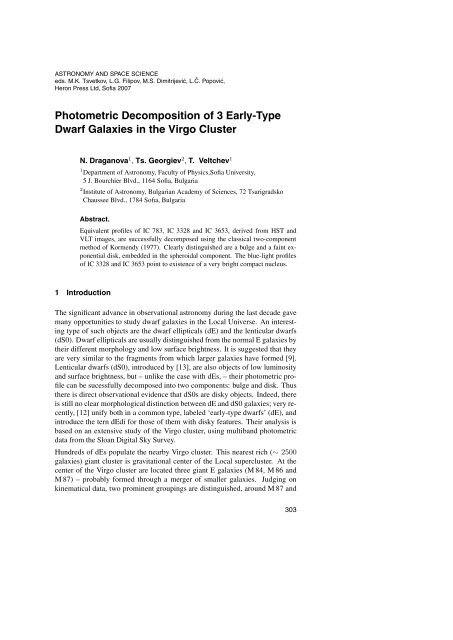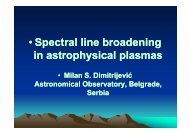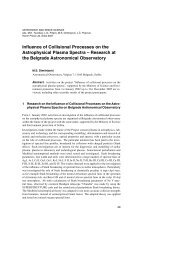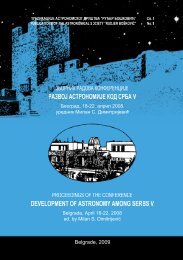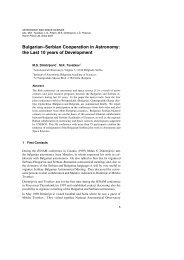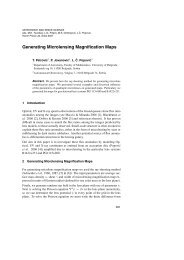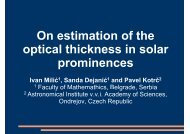Photometric Decomposition of 3 Early-Type Dwarf Galaxies in the ...
Photometric Decomposition of 3 Early-Type Dwarf Galaxies in the ...
Photometric Decomposition of 3 Early-Type Dwarf Galaxies in the ...
Create successful ePaper yourself
Turn your PDF publications into a flip-book with our unique Google optimized e-Paper software.
ASTRONOMY AND SPACE SCIENCEeds. M.K. Tsvetkov, L.G. Filipov, M.S. Dimitrijević, L.Č. Popović,Heron Press Ltd, S<strong>of</strong>ia 2007<strong>Photometric</strong> <strong>Decomposition</strong> <strong>of</strong> 3 <strong>Early</strong>-<strong>Type</strong><strong>Dwarf</strong> <strong>Galaxies</strong> <strong>in</strong> <strong>the</strong> Virgo ClusterN. Draganova 1 , Ts. Georgiev 2 , T. Veltchev 11 Department <strong>of</strong> Astronomy, Faculty <strong>of</strong> Physics,S<strong>of</strong>ia University,5 J. Bourchier Blvd., 1164 S<strong>of</strong>ia, Bulgaria2 Institute <strong>of</strong> Astronomy, Bulgarian Academy <strong>of</strong> Sciences, 72 TsarigradskoChaussee Blvd., 1784 S<strong>of</strong>ia, BulgariaAbstract.Equivalent pr<strong>of</strong>iles <strong>of</strong> IC 783, IC 3328 and IC 3653, derived from HST andVLT images, are successfully decomposed us<strong>in</strong>g <strong>the</strong> classical two-componentmethod <strong>of</strong> Kormendy (1977). Clearly dist<strong>in</strong>guished are a bulge and a fa<strong>in</strong>t exponentialdisk, embedded <strong>in</strong> <strong>the</strong> spheroidal component. The blue-light pr<strong>of</strong>iles<strong>of</strong> IC 3328 and IC 3653 po<strong>in</strong>t to existence <strong>of</strong> a very bright compact nucleus.1 IntroductionThe significant advance <strong>in</strong> observational astronomy dur<strong>in</strong>g <strong>the</strong> last decade gavemany opportunities to study dwarf galaxies <strong>in</strong> <strong>the</strong> Local Universe. An <strong>in</strong>terest<strong>in</strong>gtype <strong>of</strong> such objects are <strong>the</strong> dwarf ellipticals (dE) and <strong>the</strong> lenticular dwarfs(dS0). <strong>Dwarf</strong> ellipticals are usually dist<strong>in</strong>guished from <strong>the</strong> normal E galaxies by<strong>the</strong>ir different morphology and low surface brightness. It is suggested that <strong>the</strong>yare very similar to <strong>the</strong> fragments from which larger galaxies have formed [9].Lenticular dwarfs (dS0), <strong>in</strong>troduced by [13], are also objects <strong>of</strong> low lum<strong>in</strong>osityand surface brightness, but – unlike <strong>the</strong> case with dEs, – <strong>the</strong>ir photometric pr<strong>of</strong>ilecan be sucessfully decomposed <strong>in</strong>to two components: bulge and disk. Thus<strong>the</strong>re is direct observational evidence that dS0s are disky objects. Indeed, <strong>the</strong>reis still no clear morphological dist<strong>in</strong>ction between dE and dS0 galaxies; very recently,[12] unify both <strong>in</strong> a common type, labeled ‘early-type dwarfs’ (dE), and<strong>in</strong>troduce <strong>the</strong> tern dEdi for those <strong>of</strong> <strong>the</strong>m with disky features. Their analysis isbased on an extensive study <strong>of</strong> <strong>the</strong> Virgo cluster, us<strong>in</strong>g multiband photometricdata from <strong>the</strong> Sloan Digital Sky Survey.Hundreds <strong>of</strong> dEs populate <strong>the</strong> nearby Virgo cluster. This nearest rich (∼ 2500galaxies) giant cluster is gravitational center <strong>of</strong> <strong>the</strong> Local supercluster. At <strong>the</strong>center <strong>of</strong> <strong>the</strong> Virgo cluster are located three giant E galaxies (M 84, M 86 andM 87) – probably formed through a merger <strong>of</strong> smaller galaxies. Judg<strong>in</strong>g onk<strong>in</strong>ematical data, two prom<strong>in</strong>ent group<strong>in</strong>gs are dist<strong>in</strong>guished, around M 87 and303
N. Draganova, Ts. Georgiev, T. VeltchevM 86. Some authors differentiate five ma<strong>in</strong> groups: V1 (M 87), V2 (M 49), V3(M-cloud), V4 (M 59) and V5 (W-cloud) (see e.g. [5]). Objects <strong>of</strong> <strong>the</strong> presentstudy are three early-type dwarf galaxies, reveal<strong>in</strong>g disk features, members <strong>of</strong>three different groups <strong>of</strong> <strong>the</strong> Virgo cluster (Table 1).Table 1. General data on <strong>the</strong> chosen galaxies. Abbreviations: CE95 [5], B – barredgalaxy, R – galaxy with a r<strong>in</strong>g (classification: Leda database).IC RA DEC Classification Membership DM B Tnumber (J2000) (J2000) NED Leda (CE95) [mag] [mag]IC 783 12:21:38.78 +15:44:42.7 SAB(rs)0 S0-a (B) V1 (M 87) 31.46 14.94IC 3328 12:25:57.81 +10:03:12.8 dE,N E-S0 (R) V2 (M 49) 30.98 14.49IC 3653 12:41:15.72 +11:23:13.5 E3 S0 V4 (M 59) 29.90 13.93The galaxy IC 783 was orig<strong>in</strong>ally classified as type S0 [4] because <strong>of</strong> suspecteddisk component. A research <strong>of</strong> its circumnuclear region (r gc < 20 ′′ ) revealedexistence <strong>of</strong> a two-component spiral structure, possibly with r<strong>in</strong>g or bar ( [1,2]).Spiral structure was discovered also <strong>in</strong> IC 3328 by [10] – it is strongly w<strong>in</strong>ded,compact and centered <strong>in</strong> <strong>the</strong> galaxy center. The nucleus is well pronouncedand <strong>the</strong>refore IC 3328 was classified as ‘dwarf elliptical nucleated’ (dE,N), although[10] argue that it is most probably dS0. In contrast to <strong>the</strong> former twogalaxies, IC 3653 is classified as a normal elliptical (cf. [8]). However, its morphologyand photometric features are typical for dwarf ellipticals [15]. There isno observational <strong>in</strong>dication that it possesses a disk.2 Data AnalysisIn <strong>the</strong> present work we use high-quality images from <strong>the</strong> FORS1 archive (VLT)and <strong>the</strong> ACS Virgo Survey (HST). The FORS1 images have been taken <strong>in</strong> <strong>the</strong>red broadband filter R, with typical resolution <strong>of</strong> 0. ′′ 2 per pixel, and we processed<strong>the</strong>m prelim<strong>in</strong>ary to remove <strong>the</strong> bias and to perform a flat field correction. TheHST images have been taken with <strong>the</strong> Wide Field Channel (WFC) <strong>of</strong> <strong>the</strong> AdvancedCamera for Surveys (ACS), which allows an image scale <strong>of</strong> 0. ′′ 05 perpixel. The used broadband F475W and F850LP filters are characterized by highthroughput and correspond respectively to g’ and z’ filters <strong>in</strong> <strong>the</strong> Sloan DigitizedSky Survey system. The objects, covered by <strong>the</strong> ACS Virgo Survey, were a subset<strong>of</strong> 100 galaxies from <strong>the</strong> Virgo Cluster Catalog (VCC) with morphologicaltypes <strong>of</strong> E, S0, dE, dE,N, dS0 or dS0,N [6].In a previous work we performed surface photometry <strong>of</strong> <strong>the</strong> chosen three galaxies[7]. The applied methods confirmed <strong>the</strong> existence <strong>of</strong> disky structures <strong>in</strong>IC 783 and IC 3328 and <strong>in</strong>dicated possible disk <strong>in</strong> IC 3653. Therefore, a carefulphotometric decomposition is required for quantitative structure analysis <strong>of</strong>this galaxies. We applied a decomposition procedure, us<strong>in</strong>g <strong>the</strong> classical two-304
<strong>Early</strong>-<strong>Type</strong> <strong>Dwarf</strong> <strong>Galaxies</strong> <strong>in</strong> <strong>the</strong> Virgo Clustercomponent method <strong>of</strong> [11]. It was orig<strong>in</strong>ally <strong>in</strong>vented to study <strong>the</strong> radial lightdistribution <strong>in</strong> galaxies with well pronounced spheroid component, clearly dom<strong>in</strong>at<strong>in</strong>g<strong>in</strong> large central regions. As one can see from <strong>the</strong> presented pr<strong>of</strong>iles, <strong>the</strong>case with our objects is different (see especially Figures 3 and 4). Never<strong>the</strong>less,Kormendy’s method is successful when approximat<strong>in</strong>g radial surface brightnessdistribution μ(r) <strong>of</strong> <strong>the</strong> components by means <strong>of</strong> Sersic’s law [14]:μ bul (r) =μ bul (0) + 1.086 (r/h bul ) Nbul ,μ disk (r) =μ disk (0) + 1.086 (r/h disk ) Ndisk ,where h is a scal<strong>in</strong>g factor and N is exponential-power decimal number, typically<strong>in</strong> range [0,2]. (In <strong>the</strong> scientific literature, <strong>the</strong> <strong>in</strong>dex N is usually written<strong>in</strong> <strong>the</strong> form 1/n.) Up to ten iterations <strong>of</strong> <strong>the</strong> procedure are sufficient to obta<strong>in</strong>appropriate solution. Generally, <strong>the</strong> cases when N1 represent variousconvex shapes and <strong>the</strong> case N =2gives Gaussian shape. The radial pr<strong>of</strong>iles<strong>of</strong> small ellipticals, <strong>the</strong> bulges <strong>of</strong> late type galaxies as well disks <strong>of</strong> early typegalaxies <strong>in</strong> <strong>the</strong> sample <strong>of</strong> [11] may be modeled with N>1.3 Results and DiscussionThe one-dimensional photometric pr<strong>of</strong>iles were obta<strong>in</strong>ed by use <strong>of</strong> <strong>the</strong> programpackage ple<strong>in</strong>pot, developed at <strong>the</strong> Observatory <strong>of</strong> Lyon, and are shown withfilled symbols <strong>in</strong> Figure 1–5. The parameters <strong>of</strong> <strong>the</strong> bulge and disk Sersic fitsare given <strong>in</strong> Table 2.The results <strong>of</strong> IC 783 reveal a well pronounced disk, reach<strong>in</strong>g to <strong>the</strong> outer regions<strong>of</strong> <strong>the</strong> galaxy. The steep bulge pr<strong>of</strong>ile <strong>in</strong>dicates strong concentration <strong>of</strong> <strong>the</strong>spherical component toward <strong>the</strong> bright nucleus (Figure 1). However, we po<strong>in</strong>tout some uncerta<strong>in</strong>ty <strong>in</strong> <strong>the</strong> estimates <strong>of</strong> N bul and h bul due to unusually high centrallum<strong>in</strong>osity. (The problem is even more severe <strong>in</strong> case with <strong>the</strong> z’ image <strong>of</strong>IC 3328; see below.) Thus <strong>the</strong> extension <strong>of</strong> dom<strong>in</strong>at<strong>in</strong>g spherical component stillTable 2. <strong>Decomposition</strong> with Sersic pr<strong>of</strong>iles <strong>of</strong> IC 783 and IC 3328.Galaxy d (μ=25) Disk Parameters <strong>of</strong> Sersic law fits[arcsec] [kpc] N bul μ bul(0) h bul N disk μ disk(0) h diskIC 783 (R) 131.2 12.45 0.958 18.04 0.688 1.011 19.45 13.07IC 3328 (g’) 54.2 4.13 0.272 12.26
N. Draganova, Ts. Georgiev, T. VeltchevFigure 1. <strong>Decomposition</strong> <strong>of</strong> <strong>the</strong> radial surface brightness distribution (large dots) <strong>of</strong>IC 783 <strong>in</strong> R filter. Sersic fits <strong>of</strong> <strong>the</strong> bulge (dotted) and disk (solid) are shown.needs to be clarified. At galactocentric distances > 5 arcsec disk component isdom<strong>in</strong>ant. As seen from a brief look at Figure 3 <strong>in</strong> [2], our disk pr<strong>of</strong>ile covers<strong>the</strong> region <strong>of</strong> spiral arms and <strong>the</strong> unidentified central structure (bar or r<strong>in</strong>g). Thetransition between arms and central structure occurs at r gc ∼ 12 arcsec wherelight bend <strong>in</strong> <strong>the</strong> pr<strong>of</strong>ile is observed (Figure 1).<strong>Photometric</strong> pr<strong>of</strong>iles <strong>of</strong> IC 3328 <strong>in</strong> g’ and z’ are also clearly decomposed <strong>in</strong>tobulge and disk. The comparison between <strong>the</strong> two decompositions surpris<strong>in</strong>glyshows different behaviour <strong>in</strong> <strong>the</strong> circumnuclear region (cf. Figures 2 and 3).Impressive is <strong>the</strong> extremely bright nucleus, seen <strong>in</strong> g’ passband, that almost disappears<strong>in</strong> z’. Existence <strong>of</strong> foreground object is not a plausible explanation <strong>in</strong>Figure 2. The same like Figure 1 but for IC 3328 (g’ filter). The symbols are <strong>the</strong> same.306
<strong>Early</strong>-<strong>Type</strong> <strong>Dwarf</strong> <strong>Galaxies</strong> <strong>in</strong> <strong>the</strong> Virgo ClusterFigure 3. The same like Figure 1 but for IC 3328 (z’ filter).view <strong>of</strong> <strong>the</strong> short life and small spatial density <strong>of</strong> lum<strong>in</strong>ous OB stars. Moreover,similar behavior is observed <strong>in</strong> case with IC 783 – although its nucleus is notthat bright. If <strong>the</strong> nucleus <strong>of</strong> IC 3328 is really very bright <strong>in</strong> blue light, it maybe speculated that it harbors young, compact stellar cluster(s). The disk componentis blue ((g’-z’) −0.2), reveal<strong>in</strong>g no color gradient with <strong>the</strong> galactocentricdistance. Tak<strong>in</strong>g <strong>in</strong>to account that <strong>the</strong> disk is purely stellar, this behaviour <strong>in</strong>dicateslack <strong>of</strong> huge, non-axisymmetric concentrations <strong>of</strong> massive stars. Indeed,<strong>the</strong> surface photometry <strong>of</strong> [10] (see Figure 1 <strong>the</strong>re) clearly shows regular spiralstructure, with uniform light distribution, reach<strong>in</strong>g nearly to <strong>the</strong> galaxy center.<strong>Decomposition</strong> <strong>of</strong> radial surface brightness pr<strong>of</strong>ile <strong>of</strong> IC 3328, us<strong>in</strong>g groundbased(VLT) and obviously deeper observations <strong>in</strong> R passband, <strong>in</strong>dicates alsoFigure 4. The same like Figure 1 but for IC 3328 (R filter).307
N. Draganova, Ts. Georgiev, T. VeltchevFigure 5. Radial brightness pr<strong>of</strong>ile <strong>of</strong> IC 3653 <strong>in</strong> g’ and z’ filters.lightly concave bulge pr<strong>of</strong>ile and lightly convex disk pr<strong>of</strong>ile (Figure 4). In all 4decompositions, we found nearly flat, Freeman type pr<strong>of</strong>iles <strong>of</strong> <strong>the</strong> bulge and <strong>the</strong>disk – as one can expect when consider<strong>in</strong>g dwarf galaxies.<strong>Photometric</strong> pr<strong>of</strong>iles <strong>of</strong> IC 3653 <strong>in</strong> g’ and z’ cannot be decomposed through <strong>the</strong>method <strong>of</strong> [11]. The pr<strong>of</strong>iles <strong>in</strong> <strong>the</strong> <strong>in</strong>ner 10 ′′ have mixed concave-convex shapethat cannot be approximated by Sersic law. Probably this <strong>in</strong>dicates a more complexcentral structure which we <strong>in</strong>tend to study by use <strong>of</strong> o<strong>the</strong>r approaches. Surfacephotometry techniques, applied by us recently, give no clear <strong>in</strong>dication forexistence <strong>of</strong> disky structure [7].AcknowledgmentsThe authors gratefully acknowledge support from <strong>the</strong> Bulgarian National ScienceFoundation, grant F-1302/03.308
<strong>Early</strong>-<strong>Type</strong> <strong>Dwarf</strong> <strong>Galaxies</strong> <strong>in</strong> <strong>the</strong> Virgo ClusterReferences[1] F. Barazza, B. B<strong>in</strong>ggeli, H. Jerjen (2001) <strong>in</strong> <strong>Dwarf</strong> <strong>Galaxies</strong> and <strong>the</strong>ir Environment,ed. K.S. de Boer, R.-J. Dettmar, U. Kle<strong>in</strong> (Shaker Verlag), 243.[2] F. Barazza, B. B<strong>in</strong>ggeli, H. Jerjen (2002) A&A 391 823.[3] F. Barazza, B. B<strong>in</strong>ggeli, H. Jerjen (2003) A&A 407 121.[4] B. B<strong>in</strong>ggeli, L. Cameron (1991) A&A 252 27.[5] N. Caon, M. E<strong>in</strong>asto (1995) MNRAS 273 913.[6] P. Cote, J. Blakeslee et al. (2004) ApJS 53 223.[7] N. Draganova, Ph. Prugniel (2005) Ann. de l’Univ. de S<strong>of</strong>ia 98 (<strong>in</strong> press).[8] G. Gavazzi, A. Donati, O. Cucciati, S. Sabat<strong>in</strong>i, A. Boselli, J. Davies, S. Zibetti(2005) A&A 430 411.[9] R. Guzman, A. Graham, A. Matković, I. Vass, J. Gorgas, N. Cardiel (2003) ASPConf. 297 271.[10] H. Jerjen, A. Kalnajs, B. B<strong>in</strong>ggeli (2000) A&A 358 845.[11] J. Kormendy (1977) ApJ 217 406.[12] Th. Lisker, E. Grebel, B. B<strong>in</strong>ggeli (2006) AJ (accepted).[13] A. Sandage, B. B<strong>in</strong>ggeli (1984) AJ 89 919.[14] J. Sersic (1968) Atlas de Galaxes Australes, Cordoba Obs. Astron., Univ. Nac. Cordoba.[15] F. Simien, Ph. Prugniel (2002) A&A 384 371.309


